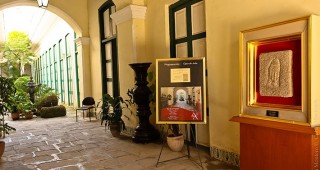
Museo del Naipe Marqués de Prado Ameno LH  2
2
Opened on May 2, 2001, the small yet immensely impressive Playing Card Museum occupies the ground floor of the Casa del Marqués de Prado Amero, dating from the 17th century and the oldest building in …

Hotel Presidente LH  2
2
This is Havana’s first skyscraper and was inaugurated on December 28, 1928. It took its name from the street it is situated in and is the only hotel that features Cuba’s coat of arms on its façade. It …
 ModernROOMS: 158Calzada #110 esquina a G (Avenida de los Presidentes)
ModernROOMS: 158Calzada #110 esquina a G (Avenida de los Presidentes) 
Clock Tower LH  2
2
Between 1921 and 1924, a clock tower was built on Fifth Avenue. It was designed by New Yorker John H. Duncan, one of the architects that contributed to the layout of the avenue and who also designed t …

Iglesia y Convento de Santa Catalina de Siena LH  2
2
The Convent of the Dominican Sisters of Saint Catherine of Siena moved from its former site in Old Havana to a new and prime location in El Vedado on May 13, 1918. The construction of the convent and …
 EclecticPaseo entre 23 y 25
EclecticPaseo entre 23 y 25 
Patronato de la Casa de la Comunidad Hebrea y Gran Sinagoga bet Shalom LH  2
2
This is the biggest of Cuba’s five synagogues and is considered one of the most important architectural works in the country. It has a hard-looking exterior with vertical lines that make reference to …
 ModernI #241, entre 13 y 15
ModernI #241, entre 13 y 15 
Fuente de las Américas LH  2
2
The Fuente de Las Américas, built as a tribute to the discoverer of the Americas, was inaugurated in 1924 as part of the construction of Avenida de las Américas, now known as 5ta Avenida. Made in whit …

Hotel Telégrafo LH  2+
2+
Initially located on Amistad Street and relocated in 1899 to its present site, the Telégrafo Hotel was rebuilt in 1911 and was considered then one of the most modern hotels in Havana. In 2001 it was r …
 $48 - $69ROOMS: 63Prado No. 408 esquina a Neptuno
$48 - $69ROOMS: 63Prado No. 408 esquina a Neptuno 
Casa de Asia LH  2
2
Opened in 1997, this small museum—upstairs in a townhouse mansion built in 1688—displays collections that depict the lifestyle, dress, religious beliefs, rituals and traditions from different Asiatic …

Banco de La Habana LH  2
2
This 1915 two-story building was made of reinforced concrete. Its façade was composed of elements of the Ionic order and stood out because of its semicircular portico and its beautiful wooden door, wh …
 EclecticAdmission: FreeCuba e/ Obispo y Obrapía, Habana Vieja
EclecticAdmission: FreeCuba e/ Obispo y Obrapía, Habana Vieja 
Parque de la Fraternidad LH  2
2
By 1790, this originally mangrove swampy area became Campo de Marte, a military practice range, which was expanded in 1793 thanks to a project by Belgian engineer Agustin Cramer. And after Bishop Espa …







